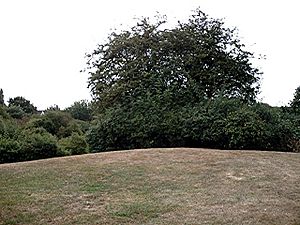Rayleigh Castle facts for kids
Rayleigh Castle, also known as Rayleigh Mount, was a castle made of stone and wood. It was built near the town of Rayleigh in Essex, England. This happened in the 11th century, soon after the Normans took over England. Today, only the large earth mounds, called a motte-and-bailey, are left.
Contents
What Was Rayleigh Castle Like?
Rayleigh Castle is one of 48 castles mentioned in the Domesday Survey from 1086. It was the only castle listed in Essex at that time. The Survey shows that a man named Swein built the castle on his land. Swein was the son of Robert FitzWimarc, a Norman lord who was a friend of Edward the Confessor, a king of England.
Swein was one of the richest landowners in Essex after the Normans arrived. Most landowners had their properties spread out, but Swein's lands were mostly in the areas of Rochford and Barstable. Rayleigh Castle was the main center for managing these lands.
The design of Rayleigh Castle was similar to two other motte-and-bailey castles in Essex: Pleshey and Ongar.
Who Owned Rayleigh Castle?
After Swein died, his son Robert of Essex took over the castle. Then, Robert's son, Henry of Essex, became the owner. Around 1140, the large mound (motte) of the castle was covered with stone rubble.
In 1163, Henry of Essex was accused of being a coward in battle. He had to fight a special duel, which he lost. Because of this, King Henry II took the castle and its lands. The king made many changes to the castle in 1172 and again in 1183-84.
Later, around 1200, King John gave the property to Hubert de Burgh. Hubert probably used stones from Rayleigh Castle to build a new castle. He started building this new castle in 1230, about 5 kilometers away, at Hadleigh.
When Did Rayleigh Castle Stop Being Used?
After Hubert de Burgh's son died in the late 1200s, the castle went back to the King. Papers from 1279 to 1303 mention that the castle mound was used for grazing animals. This means the castle was likely no longer used for defense.
In 1394, King Richard II allowed the people of Rayleigh to use the castle's foundations for stone. Since only the foundations were mentioned, it's likely that most of the castle's stone buildings were already gone by then.
What Happened to the Site?
After the castle was no longer used, the land was used for grazing sheep. Photos from the 1920s show the mound without many large trees or bushes. The sheep kept them from growing. However, since the grazing stopped, many large trees have grown on the site.
The National Trust, which now looks after the site, does not plan to remove these trees. They are worried that removing them might disturb any old historical items buried underground.
During the Second World War, a ship called the Empire Rest was planned to be named HMS Rayleigh Castle. It was named after the castle ruins.


